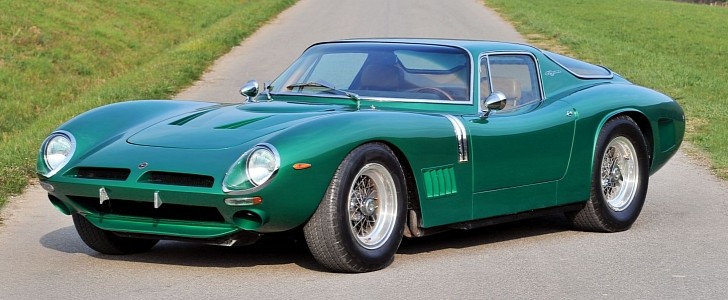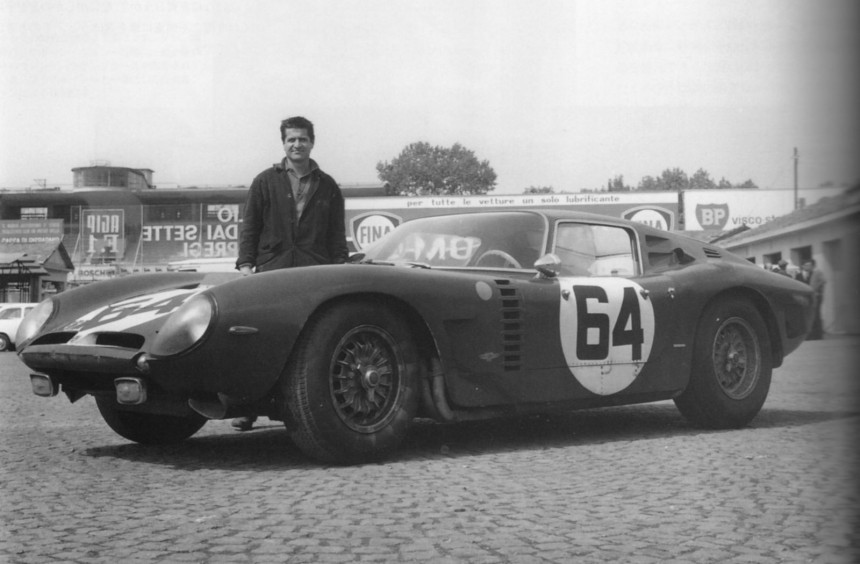In the mid-1960s, ex-Ferrari engineer Giotto Bizzarrini started his own company and blessed the automotive world with his masterpiece. Originally built as a race version of the Iso Grifo, the 5300 GT was the pinnacle of motorsport engineering in its era and the Italian saw it as the latest evolution of the legendary 250 GTO.
A test driver, designer, and brilliant engineer, Giotto Bizzarrini is among the greatest and most influential names in the automotive industry. Shortly after earning an engineering degree from the University of Pisa, he became a teacher but ultimately ended up joining Alfa Romeo. In Milan, he became a test drive and contributed to the development of the 1954 Giulietta chassis.
While working for Alfa, he quickly earned a reputation for being a skilled problem-solver, drawing the attention of Enzo Ferrari and in 1957, he took his talents to Maranello. Hired as a test driver once again, his invaluable input and creativity persuaded Ferrari to promote him to sports car development chief.
In this new position, he played an important role in the development of the 250 GT 2+2/GTE, the Testa Rossa V12 3-liter, and the 250 GT Berlinetta Passo Corto. The 250 racecars and homologation specials were also heavily influenced by his innovative ideas and technical solutions, with the legendary 250 GTO becoming his most famous creation.
Several months before the GTO was officially revealed in 1962, Bizzarrini and four other important figures at Ferrari were shockingly fired. The story goes they gave the boss an ultimatum, being displeased with his wife's increasingly toxic involvement in the decision-making. Il Commendatore (the commander, as Enzo was often called) didn't take threats too well, so he dismissed his top men without overthinking too much .
The now-former employees wanted their revenge and quickly established ATS (Automobili Turismo e Sport) with the aim of creating Formula One and GT cars that could beat Ferrari. That never worked out, but the company was mildly successful for several years.
In 1962, Bizzarrini also founded Società Autostar, an engineering firm through which he would embark on several independent projects. The first was a close collaboration with Iso Automotoveicoli S.p.A, and the second was the development of the iconic Lamborghini V12.
While working for Iso, helped built the Rivolta, the company's first luxury car, and was in charge of their next model, the esquisite Grifo. Along with the A3/L prototype that became the mass-produced Grifo GL, the engineer also created a spectacular race version codenamed A3/C (C for Corsa or race in Italian) that he saw as the spiritual successor of the Ferrari 250 GTO.
Noticeably different than its road-legal sibling, this track weapon was lower, lighter, and more aerodynamically refined. Bizzarrini knew how to build engines, but to save money and reduce development costs, he used the A3/L’s Corvette C2-derived small-block 327 V8, a unit he was a fan of, since it was reliable, smooth-running, and provided plenty of power. Of course, each powerplant shipped from the U.S. was stripped down and rebuilt in Italy, gaining various improvements that resulted in 300 to 350 hp.
In 1964, the stubborn and idealist engineer terminated his contract with Iso after a tense dispute with owner Renzo Rivolta. Although 22 A3/C prototypes were built and one of them even competed at Le Mans, finishing 14th overall, the race car would continue to be independently developed by the newly established Bizzarrini S.p.A. company.
This move gave birth to the 5300 GT Strada, the road-legal version of the A3/C and one of the most fascinating cars ever created.
Like the Corsa, it had a low-slung body designed by Bertone’s Giorgetto Giugiaro that was just exceptionally well crafted and gorgeous from every angle.
It used the same 5.4-liter Chevrolet engine that was now capable of making 365 hp. Ever since he designed the first A3/C prototype, Bizzarrini moved the powerplant closer to the center of the car, which improved weight distribution but sacrificed interior space. To make room for the engine and the BorgWarner T-10 four-speed manual, the dasboard was thinner and there was no center stack. Instead, a hatch which was designed to access the rear of the V8.
This was a full-blown race car for the streets with four-wheel disc brakes, an advanced suspension system and a powertrain conceived to rule the track. It reportedly handled impeccably and delivered an unparalleled driving experience. Compared to modern GTs, it wasn't particularly fast, sprinting to 62 mph (100 kph) from a standstill in less than 7 seconds. The top speed it could reach was around 168 mph (270 kph) but the 5300 GT handled impeccably, sounded astonishingly well and transported the person lucky enough to grip its steering wheel to the relms of driving perfection.
The revised Corsa version, which featured a tighter steering ratio, more power, a lightweight body, and no seat belts, returned to Le Mans in 1965. This time, it finished 9th overall and grabbed a class win in the process. It was the culmination of years of hard work and the ultimate proof that this was a car for the history books.
The Strada was produced in only 133 units from 1964 through 1968, making it a very rare and highly sought-after classic. The rarest of the bunch were three spyder variants: a fully convertible prototype and two production versions with removable T-tops.
Considered Giotto Bizzarrini’s masterpiece, the 5300 GT is unquestionably the greatest Italian sports car that didn’t feature any of the historic manufacturers’ badges. It is a unique race-bred machine powered by American muscle that will continue to inspire and captivate those who love cars, even in the all-electric, self-driving era.
While working for Alfa, he quickly earned a reputation for being a skilled problem-solver, drawing the attention of Enzo Ferrari and in 1957, he took his talents to Maranello. Hired as a test driver once again, his invaluable input and creativity persuaded Ferrari to promote him to sports car development chief.
In this new position, he played an important role in the development of the 250 GT 2+2/GTE, the Testa Rossa V12 3-liter, and the 250 GT Berlinetta Passo Corto. The 250 racecars and homologation specials were also heavily influenced by his innovative ideas and technical solutions, with the legendary 250 GTO becoming his most famous creation.
The now-former employees wanted their revenge and quickly established ATS (Automobili Turismo e Sport) with the aim of creating Formula One and GT cars that could beat Ferrari. That never worked out, but the company was mildly successful for several years.
In 1962, Bizzarrini also founded Società Autostar, an engineering firm through which he would embark on several independent projects. The first was a close collaboration with Iso Automotoveicoli S.p.A, and the second was the development of the iconic Lamborghini V12.
While working for Iso, helped built the Rivolta, the company's first luxury car, and was in charge of their next model, the esquisite Grifo. Along with the A3/L prototype that became the mass-produced Grifo GL, the engineer also created a spectacular race version codenamed A3/C (C for Corsa or race in Italian) that he saw as the spiritual successor of the Ferrari 250 GTO.
In 1964, the stubborn and idealist engineer terminated his contract with Iso after a tense dispute with owner Renzo Rivolta. Although 22 A3/C prototypes were built and one of them even competed at Le Mans, finishing 14th overall, the race car would continue to be independently developed by the newly established Bizzarrini S.p.A. company.
This move gave birth to the 5300 GT Strada, the road-legal version of the A3/C and one of the most fascinating cars ever created.
It used the same 5.4-liter Chevrolet engine that was now capable of making 365 hp. Ever since he designed the first A3/C prototype, Bizzarrini moved the powerplant closer to the center of the car, which improved weight distribution but sacrificed interior space. To make room for the engine and the BorgWarner T-10 four-speed manual, the dasboard was thinner and there was no center stack. Instead, a hatch which was designed to access the rear of the V8.
This was a full-blown race car for the streets with four-wheel disc brakes, an advanced suspension system and a powertrain conceived to rule the track. It reportedly handled impeccably and delivered an unparalleled driving experience. Compared to modern GTs, it wasn't particularly fast, sprinting to 62 mph (100 kph) from a standstill in less than 7 seconds. The top speed it could reach was around 168 mph (270 kph) but the 5300 GT handled impeccably, sounded astonishingly well and transported the person lucky enough to grip its steering wheel to the relms of driving perfection.
The Strada was produced in only 133 units from 1964 through 1968, making it a very rare and highly sought-after classic. The rarest of the bunch were three spyder variants: a fully convertible prototype and two production versions with removable T-tops.
Considered Giotto Bizzarrini’s masterpiece, the 5300 GT is unquestionably the greatest Italian sports car that didn’t feature any of the historic manufacturers’ badges. It is a unique race-bred machine powered by American muscle that will continue to inspire and captivate those who love cars, even in the all-electric, self-driving era.





















